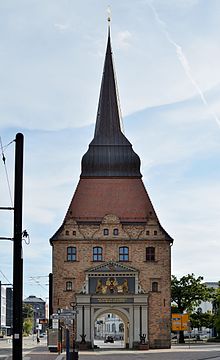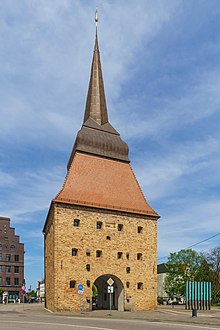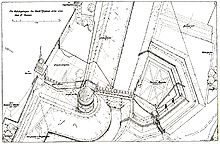Stone Gate (Rostock)
The stone gate in its current form is a gate built in the Renaissance style between 1574 and 1577 in the south of the historic Rostock city fortifications . Along with the Kröpeliner Tor , the Petri and Mühlentor, it was one of the four main gates of the city and was part of the 22 gates that belonged to the former wall ring.
History of the gate
First goal
The gate, built in 1279, soon replaced the Kuhtor, a little further east, as the main portal of the city, which it remained for the entire Middle Ages. It is likely that it was similar in size to the early Kröpeliner Tor , which was built at the same time. It was built in the course of the establishment of a fortification for the city of Rostock with a wall, towers and gates after the three original city cores united in 1265. The Steintor still leads across Steinstrasse to the Neuer Markt , which is the center of the city and where both the town hall and St. Mary's Church are located. The princes could ride into the city without detours on this (stone) road, which was paved for them.
However, the stone gate only stood in its original form for almost 300 years. In disputes between Rostock and Schwerin in 1565, the issue was, among other things, the introduction of a beer share in favor of the dukes. After Rostock refused to take the formal oath of homage to Johann Albrecht I , he went with 500 riders through the stone gate into the city and in 1566 left the stone gate, its front gate, the Zwingerhof with its gate, part of the city wall from the Wiekhaus at the Dominican monastery to the cow gate and the the monastery "tower on the Rammelsberg", the predecessor of the present-day location Busch tower (or Fangelturms) with ramparts, moats and bridges, and also parts of the east and south sides grind , and let these stones a fortress in today's Rose garden building. Only the First Rostock Inheritance Treaty of September 21, 1573, in which the sovereign rulers were guaranteed hereditary rule over the city for centuries, so Rostock was bound for a long time, and they were also recognized as the highest judge, ended the conflict.
Second goal
After the citizens had bought the right to do so from the duke, they razed the fortress the following spring. From 1574 to 1577, the expensive reconstruction of the wall, the lagebush tower and the stone gate in the style of the Dutch Renaissance took place . A rarity for this period is that the responsible construction workers for the new building can be traced directly. The gate was created under the direction of Antonius Wahrholt, the sculptor Hans Borgloh was also involved, the master carpenters was Hinrich Kate, who was responsible for the earthworks by Wallmeister Otto.
The portrayal of the gate on the Vicke-Schorler roll shows its shape at that time. The aedicule above the gateway goes the full width of the building. In contrast to today, Schorler's depiction also includes cartouches next to the coat of arms-bearing lions. In the left is the text: Whoever has trawled God has bawt. (after the beginning of a chorale by Joachim Magdeburg, 1572), in the right through you will be stylish and hope you will sterck. (after Isaiah 30:15). The inscription under the coats of arms also differs from today's - although the meanings do not differ significantly. Both relate directly to the conflict with the duke that led to the demolition of the old gate. At Schorler it is called: Dominus confortet seras portarum et benedicat / filiis tuis. Intra te concordia, publica felicitas perpetua. (May the Lord strengthen the bars of the gates and bless your children in you. May there be unity and lasting public welfare). The first part is the transformation of a statement into a request from Psalm 147:13 of the Bible , which says: Quoniam confortavit seras portarum tuarum; benedixit filiis tuis in te. (According to Luther : Because he ( Yahweh ) tightens the bars of your ( Jerusalem ) gates, and blesses your children in your midst.) In the line below in Schorler's description: Common peace a beautiful stand, through this you get town and country. One can assume that this part was added by Schorler.
In today's version, the inscription on the gate simply reads: “Sit intra te concordia et publica felicitas.” - Within your walls there is unity and public welfare.
In Schorler's depiction, the roof is made of shingles instead of slate .
The field side deliberately only bears the city and state coat of arms in a small rectangle. The stones for the portcullis and the loopholes can also be seen. This simplicity on the side facing away from the city showed defensibility and demonstrated strength. On the other hand, wealth was represented on the city side. Two lions bear three historical coats of arms: the coat of arms with the griffin (coat of arms of the princes), one with the bull's head (the large city seal) and the three-colored shield with griffin (the Hanseatic city coat of arms). Including the motto of the city.
On the field side of the gate there was also the Zwinger , a wide round tower that was dismantled in 1849. In addition, the gate had a direct connection to the city wall for a long time, which was not preserved because of the course of the road. An extensive restoration of the building was necessary after the destruction by the bombing of the Royal Air Force in 1942. The spire was destroyed, the gate burned down to the surrounding walls. The reconstruction took place from 1950 to 1956 in the original form by the master builder Grützmacher. In 2005, the missing connection to the city wall was symbolically restored by twelve steles on the east side that glow green at night .
Web links
- Steintor Rostock as a 3D model in SketchUp's 3D warehouse
literature
- AF Lorenz: On the history of the Rostock city fortifications. An attempt at reconstruction. Rostock 1935. (New edition: On the history of the Rostock city fortifications. Edition M, Weimar / Rostock 2007, ISBN 978-3-933713-24-7 )
- Horst Witt (ed.): The real "Abcontrafactur" of the sea and Hanseatic city of Rostock by the shopkeeper Vicke Schorler. Hinstorff, Rostock 1989, ISBN 3-356-00175-2 .
Coordinates: 54 ° 5 ′ 11.9 ″ N , 12 ° 8 ′ 27.2 ″ E





